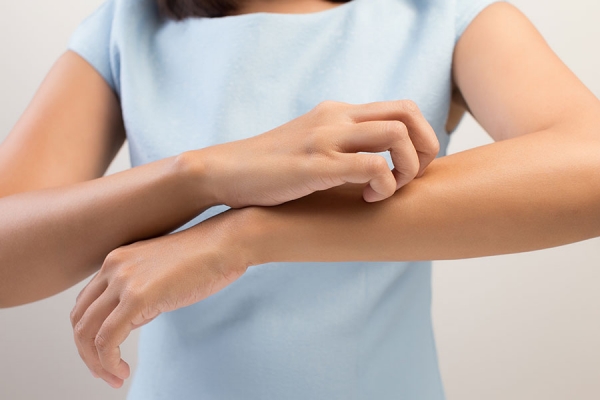Eczema in the Spa: Identification, and Treatment

An initial client consult that includes a thorough intake form and interview, in addition to the physical examination of the skin, will serve as the basis for diagnosing the presence and type of eczema. The most important thing we can do as aestheticians in treating eczema is to have clients eliminate as many triggers as possible and recommend products that will repair the skin barrier. A client’s compliance and consistent homecare are critical to strengthening their natural barrier and reducing eczema flareups.
A note of caution: be clear with the client at what point the condition is manageable through aesthetic practices and at what point temporary medicinal solutions should be sought in order to return the skin to an aesthetically manageable level.
ELIMINATING TRIGGERS AND IRRITANTS
Environmental or “choice” irritants should be eliminated as best as possible. Have clients abide as follows:
avoid products containing: artificial fragrance (natural or synthetic), artificial colorants, sodium lauryl sulfate, sodium
avoid any treatments or products that would further compromise the skin’s barrier, such as microdermabrasion, aggressive peels, scrubs, or
use household surface cleaners and disinfectants with nitrile gloves to protect the skin.
use laundry detergent that is fragrance- and colorant-free, avoiding chlorine bleach and dryer sheets
avoid extreme heat and cold, allergens, chronic stress, foods that cause inflammation (processed), unprotected sun exposure, smoking, and
IN-CLINIC TREATMENT PROTOCOL
Cleanse to remove makeup. Apply a calming cleansing oil to the client’s skin. Perform a cleansing massage adding water as needed. Gently remove the cleanser (using the press and pickup method) with a luke warm microfiber towel or damp 100 percent cotton four by fours.
Cleanse the skin again. Apply a calming cleansing oil or gentle cleansing cream to the client’s face, neck, and décolleté. Perform a gentle hydrating cleansing and relaxing massage for 10 to 15 minutes, adding product as necessary to maintain slip. Once more, gently remove the cleanser (using the press and pickup method) with a luke warm microfiber towel or damp 100 percent cotton four by fours.
Gently exfoliate the client’s skin. If their skin is in an extremely irritated state, skip this step. Apply a gentle enzyme mask with a fan brush to their face, neck, and décolleté, covering the client’s eyes with soothing eye pads and allowing the enzyme to sit 5 to 10 minutes, depending on the client’s skin condition. Gently remove the enzyme (using the press and pickup method) with a luke warm microfiber towel or damp 100 percent cotton four by fours.
Apply a blend of calming, nutrient-rich oil to the client’s face, neck, and décolleté and gently massage the skin for approximately 10 minutes.
Perform a pressure point massage to encourage lymphatic drainage for approximately 10 minutes. Remove excess oil with a damp 100 percent cotton four by four.
Apply a calming cream mask to the client’s face, neck, and décolleté with a fan brush. Allow the mask to sit for 10 to 12 minutes. Gently remove the mask (using the press and pickup method) with a luke warm microfiber towel or damp 100 percent cotton four by fours.
Apply the appropriate calming eye care, lip care, serum, moisture cream, and sunscreen.
BASIC HOMECARE TREATMENT PROTOCOL
Educate clients on the following protocol to supplement their treatments at home:
calm and comfort the skin by cleansing twice daily with a calming oil cleanser, moving to a calming cream cleanser, if desired, once the compromised barrier has been repaired
nourish by applying a calming eye cream twice daily
repair the skin twice daily by applying a calming, nutritious oil serum, moving to a calming emulsion, if desired, once the compromised barrier has been repaired
fortify the skin by applying a calming moisture cream twice daily
protect the skin with zinc oxide or titanium dioxide broad-spectrum sunscreen daily .